Marine Collagen/Apatite Composite Scaffolds Envisaging Hard Tissue Applications
Abstract
:1. Introduction
2. Results and Discussion
2.1. Physicochemical Properties of Marine Bioapatite (mBAp)
2.2. Composite Scaffolds’ and Stability
2.3. Composite Scaffolds’ Morphology
2.4. Composite Scaffolds’ Bioactivity
2.5. Mechanical Properties of Composite Scaffolds
2.6. Cell Viability in the Composite Scaffolds
3. Materials and Methods
3.1. Marine Collagen Extraction
3.2. Marine Bioapatite Isolation
3.3. Physicochemical Characterization
3.4. Scaffold Production
3.5. Stability Assay of 3D Structures
3.6. Microcomputed Tomography of 3D Structures
3.7. Incubation in Simulated Body Fluid (SBS)
3.8. Mechanical Tests of 3D Structures
3.9. Evaluation of Cell Viability
3.10. Statistical Analysis
4. Conclusions
Author Contributions
Funding
Acknowledgments
Conflicts of Interest
References
- Calori, G.; Mazza, E.; Colombo, M.; Ripamonti, C. The use of bone-graft substitutes in large bone defects: Any specific needs? Injury 2011, 42, S56–S63. [Google Scholar] [CrossRef] [PubMed]
- Murugan, R.; Ramakrishna, S. Development of nanocomposites for bone grafting. Compos. Sci. Technol. 2005, 65, 2385–2406. [Google Scholar] [CrossRef]
- Lichte, P.; Pape, H.; Pufe, T.; Kobbe, P.; Fischer, H. Scaffolds for bone healing: Concepts, materials and evidence. Injury 2011, 42, 569–573. [Google Scholar] [CrossRef] [PubMed]
- Pallela, R.; Venkatesan, J.; Janapala, V.R.; Kim, S.K. Biophysicochemical evaluation of chitosan-hydroxyapatite-marine sponge collagen composite for bone tissue engineering. J. Biomed. Mater. Res. A 2012, 100, 486–495. [Google Scholar] [CrossRef] [PubMed]
- Silva, T.H.; Alves, A.; Ferreira, B.; Oliveira, J.M.; Reys, L.; Ferreira, R.; Sousa, R.; Silva, S.; Mano, J.; Reis, R. Materials of marine origin: A review on polymers and ceramics of biomedical interest. Int. Mater. Rev. 2012, 57, 276–306. [Google Scholar] [CrossRef]
- Kim, S.-K.; Mendis, E. Bioactive compounds from marine processing byproducts—Review. Food Res. Int. 2006, 39, 383–393. [Google Scholar] [CrossRef]
- Boutinguiza, M.; Pou, J.; Comesaña, R.; Lusquiños, F.; De Carlos, A.; León, B. Biological hydroxyapatite obtained from fish bones. Mater. Sci. Eng. C 2012, 32, 478–486. [Google Scholar] [CrossRef]
- Hoyer, B.; Bernhardt, A.; Heinemann, S.; Stachel, I.; Meyer, M.; Gelinsky, M. Biomimetically mineralized salmon collagen scaffolds for application in bone tissue engineering. Biomacromolecules 2012, 13, 1059–1066. [Google Scholar] [CrossRef] [PubMed]
- Pallela, R.; Venkatesan, J.; Bhatnagar, I.; Shim, Y.; Kim, S. Applications of Marine Collagen-Based Scaffolds in Bone Tissue Engineering; CRC Press: Boca Raton, FL, USA, 2013; pp. 519–528. [Google Scholar]
- Silva, T.H.; Moreira-Silva, J.; Marques, A.L.; Domingues, A.; Bayon, Y.; Reis, R.L. Marine origin collagens and its potential applications. Mar. Drugs 2014, 12, 5881–5901. [Google Scholar] [CrossRef] [PubMed] [Green Version]
- Gómez-Guillén, M.; Giménez, B.; López-Caballero, M.A.; Montero, M. Functional and bioactive properties of collagen and gelatin from alternative sources: A review. Food Hydrocolloid 2011, 25, 1813–1827. [Google Scholar] [CrossRef] [Green Version]
- Fernandes-Silva, S.; Moreira-Silva, J.; Silva, T.H.; Perez-Martin, R.I.; Sotelo, C.G.; Mano, J.F.; Duarte, A.R.C.; Reis, R.L. Porous hydrogels from shark skin collagen crosslinked under dense carbon dioxide atmosphere. Macromol. Biosci. 2013, 13, 1621–1631. [Google Scholar] [CrossRef] [PubMed]
- Enax, J.; Prymak, O.; Raabe, D.; Epple, M. Structure, composition, and mechanical properties of shark teeth. J. Struct. Biol. 2012, 178, 290–299. [Google Scholar] [CrossRef] [PubMed]
- López-Álvarez, M.; Pérez-Davila, S.; Rodríguez-Valencia, C.; González, P.; Serra, J. The improved biological response of shark tooth bioapatites in a comparative in vitro study with synthetic and bovine bone grafts. Biomed. Mater. 2016, 11, 035011. [Google Scholar] [CrossRef] [PubMed]
- Tian, M.; Chen, F.; Song, W.; Song, Y.; Chen, Y.; Wan, C.; Yu, X.; Zhang, X. In vivo study of porous strontium-doped calcium polyphosphate scaffolds for bone substitute applications. J. Mater. Sci. Mater. Med. 2009, 20, 1505–1512. [Google Scholar] [CrossRef] [PubMed]
- Rodríguez-Ortiz, M.E.; Canalejo, A.; Herencia, C.; Martínez-Moreno, J.M.; Peralta-Ramírez, A.; Perez-Martinez, P.; Navarro-González, J.F.; Rodríguez, M.; Peter, M.; Gundlach, K. Magnesium modulates parathyroid hormone secretion and upregulates parathyroid receptor expression at moderately low calcium concentration. Nephrol. Dial. Transpl. 2014, 29, 282–289. [Google Scholar] [CrossRef] [PubMed]
- Miki, H.; Maercklein, P.B.; Fitzpatrick, L.A. Effect of magnesium on parathyroid cells: Evidence for two sensing receptors or two intracellular pathways? Am. J. Physiol. Endocrinol. Metab. 1997, 272, E1–E6. [Google Scholar] [CrossRef] [PubMed]
- Staiger, M.P.; Pietak, A.M.; Huadmai, J.; Dias, G. Magnesium and its alloys as orthopedic biomaterials: A review. Biomaterials 2006, 27, 1728–1734. [Google Scholar] [CrossRef] [PubMed]
- Yamasaki, Y.; Yoshida, Y.; Okazaki, M.; Shimazu, A.; Uchida, T.; Kubo, T.; Akagawa, Y.; Hamada, Y.; Takahashi, J.; Matsuura, N. Synthesis of functionally graded MgCO3 apatite accelerating osteoblast adhesion. J. Biomed. Mater. Res. 2002, 62, 99–105. [Google Scholar] [CrossRef] [PubMed]
- Wiegand, A.; Buchalla, W.; Attin, T. Review on fluoride-releasing restorative materials—Fluoride release and uptake characteristics, antibacterial activity and influence on caries formation. Dent. Mater. 2007, 23, 343–362. [Google Scholar] [CrossRef] [PubMed]
- LeGeros, R. Chemical and crystallographic events in the caries process. J. Dent. Res. 1990, 69, 567–574. [Google Scholar] [CrossRef] [PubMed]
- López-Álvarez, M.; Vigo, E.; Rodríguez-Valencia, C.; Outeiriño-Iglesias, V.; González, P.; Serra, J. In vivo evaluation of shark teeth-derived bioapatites. Clin. Oral Implants Res. 2017, 28, e91–e100. [Google Scholar] [CrossRef] [PubMed]
- Hucrrns, J.M.; ClvrnnoN, M.; MlnuNo, A.N. Rare-earth-element ordering and structural variations in natural rare-earth’bearing apatites. Am. Mineral. 1991, 76, 1165–1173. [Google Scholar]
- Hughes, J.M.; Jolliff, B.L.; Rakovan, J. The crystal chemistry of whitlockite and merrillite and the dehydrogenation of whitlockite to merrillite. Am. Mineral. 2008, 93, 1300–1305. [Google Scholar] [CrossRef]
- Liu, Q.; De Wijn, J.; Van Blitterswijk, C. A Study on the Grafting Reaction of Isocyanates with Hydoxyapatite Particles. J. Biomed. Mater. Res. 1998, 40, 358–364. [Google Scholar] [CrossRef]
- Piccirillo, C.; Silva, M.; Pullar, R.; da Cruz, I.B.; Jorge, R.; Pintado, M.; Castro, P.M. Extraction and characterisation of apatite-and tricalcium phosphate-based materials from cod fish bones. Mater. Sci. Eng. C 2013, 33, 103–110. [Google Scholar] [CrossRef] [PubMed]
- Johnson, A.J.W.; Herschler, B.A. A review of the mechanical behavior of CaP and CaP/polymer composites for applications in bone replacement and repair. Acta Biomater. 2011, 7, 16–30. [Google Scholar] [CrossRef] [PubMed]
- Angele, P.; Abke, J.; Kujat, R.; Faltermeier, H.; Schumann, D.; Nerlich, M.; Kinner, B.; Englert, C.; Ruszczak, Z.; Mehrl, R. Influence of different collagen species on physico-chemical properties of crosslinked collagen matrices. Biomaterials 2004, 25, 2831–2841. [Google Scholar] [CrossRef] [PubMed]
- Bax, D.V.; Davidenko, N.; Gullberg, D.; Hamaia, S.W.; Farndale, R.W.; Best, S.M.; Cameron, R.E. Fundamental insight into the effect of carbodiimide crosslinking on cellular recognition of collagen-based scaffolds. Acta Biomater. 2017, 49, 218–234. [Google Scholar] [CrossRef] [PubMed]
- Kokubo, T.; Kim, H.-M.; Kawashita, M. Novel bioactive materials with different mechanical properties. Biomaterials 2003, 24, 2161–2175. [Google Scholar] [CrossRef]
- Jones, A.C.; Arns, C.H.; Hutmacher, D.W.; Milthorpe, B.K.; Sheppard, A.P.; Knackstedt, M.A. The correlation of pore morphology, interconnectivity and physical properties of 3D ceramic scaffolds with bone ingrowth. Biomaterials 2009, 30, 1440–1451. [Google Scholar] [CrossRef] [PubMed]
- Li, X.; Chang, J. Preparation of bone-like apatite–collagen nanocomposites by a biomimetic process with phosphorylated collagen. J. Biomed. Mater. Res. A 2008, 85, 293–300. [Google Scholar] [CrossRef] [PubMed]
- Liu, Y.; Lim, J.; Teoh, S.-H. Review: Development of clinically relevant scaffolds for vascularised bone tissue engineering. Biotechnol. Adv. 2013, 31, 688–705. [Google Scholar] [CrossRef] [PubMed]
- Chai, Y.C.; Carlier, A.; Bolander, J.; Roberts, S.J.; Geris, L.; Schrooten, J.; Van Oosterwyck, H.; Luyten, F.P. Current views on calcium phosphate osteogenicity and the translation into effective bone regeneration strategies. Acta Biomater. 2012, 8, 3876–3887. [Google Scholar] [CrossRef] [PubMed]
- Kane, R.J.; Weiss-Bilka, H.E.; Meagher, M.J.; Liu, Y.; Gargac, J.A.; Niebur, G.L.; Wagner, D.R.; Roeder, R.K. Hydroxyapatite reinforced collagen scaffolds with improved architecture and mechanical properties. Acta Biomater. 2015, 17, 16–25. [Google Scholar] [CrossRef] [PubMed]
- Nam, S.; Won, J.-E.; Kim, C.-H.; Kim, H.-W. Odontogenic differentiation of human dental pulp stem cells stimulated by the calcium phosphate porous granules. J. Tissue Eng. 2011, 812547. [Google Scholar] [CrossRef] [PubMed]
- Gentleman, E.; Stevens, M.M.; Hill, R.; Brauer, D.S. Surface properties and ion release from fluoride-containing bioactive glasses promote osteoblast differentiation and mineralization in vitro. Acta Biomater. 2013, 9, 5771–5779. [Google Scholar] [CrossRef] [PubMed] [Green Version]
- Niu, Y.; Cao, L.; Wei, J.; Ma, Y.; Song, S.; Weng, W.; Li, H.; Liu, C.; Su, J. Development of a bioactive composite of nano fluorapatite and poly (butylene succinate) for bone tissue regeneration. J. Mater. Chem. B 2014, 2, 1174–1181. [Google Scholar] [CrossRef]
- Sotelo, C.G.; Blanco Comesaña, M.; Ramos Ariza, P.; Pérez-Martín, R.I. Characterization of collagen from different discarded fish species of the West coast of the Iberian Peninsula. J. Aquat. Food Prod. Technol. 2015, 25, 388–399. [Google Scholar] [CrossRef] [Green Version]
- Delgado, L.M.; Pandit, A.; Zeugolis, D.I. Influence of sterilisation methods on collagen-based devices stability and properties. Expert Rev. Med. Devic. 2014, 11, 305–314. [Google Scholar] [CrossRef] [PubMed]
- Kokubo, T.; Takadama, H. How useful is SBF in predicting in vivo bone bioactivity? Biomaterials 2006, 27, 2907–2915. [Google Scholar] [CrossRef] [PubMed]
- Diogo, G.; Gaspar, V.; Serra, I.; Fradique, R.; Correia, I. Manufacture of β-TCP/alginate scaffolds through a Fab@ home model for application in bone tissue engineering. Biofabrication 2014, 6, 025001. [Google Scholar] [CrossRef] [PubMed]
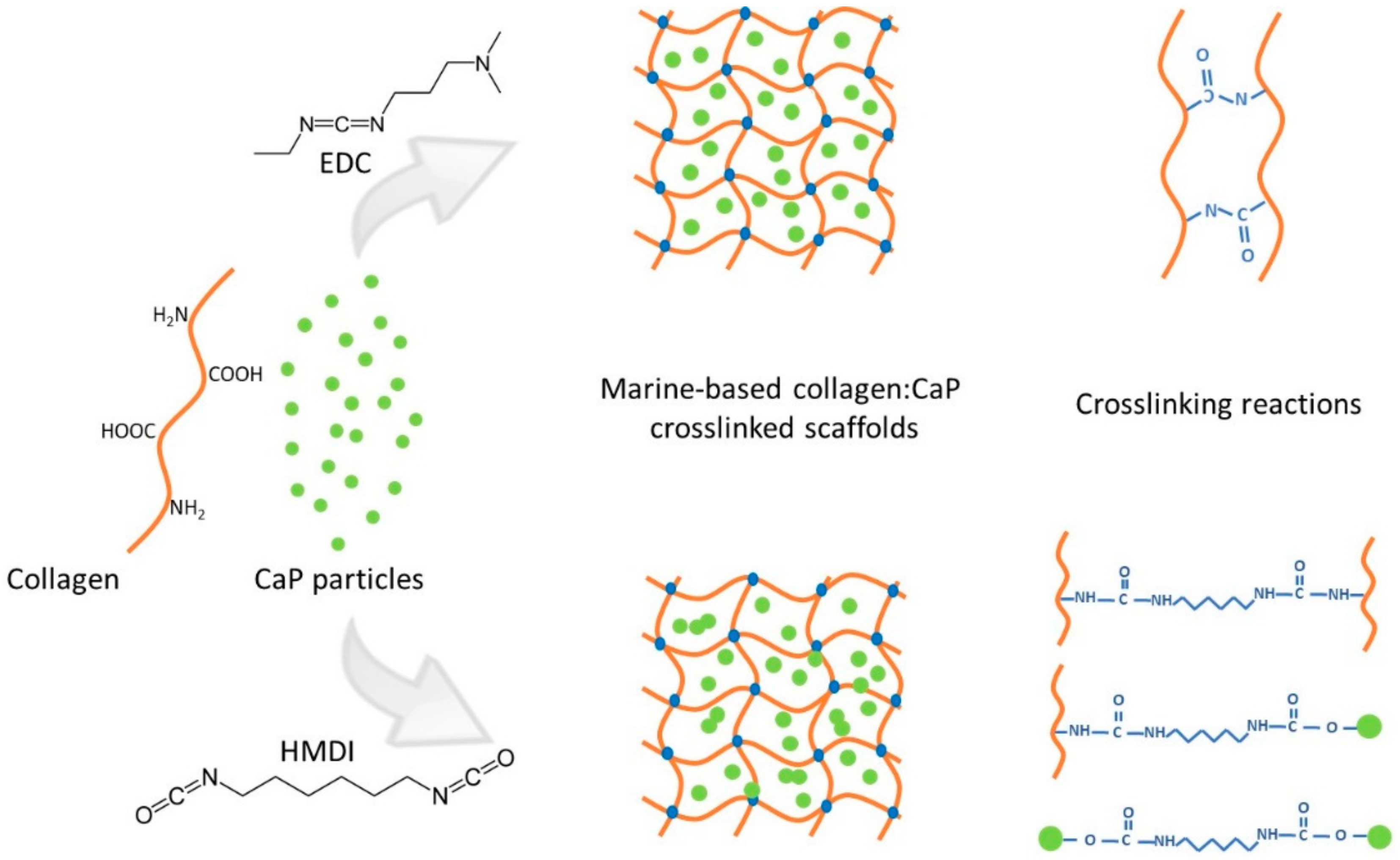


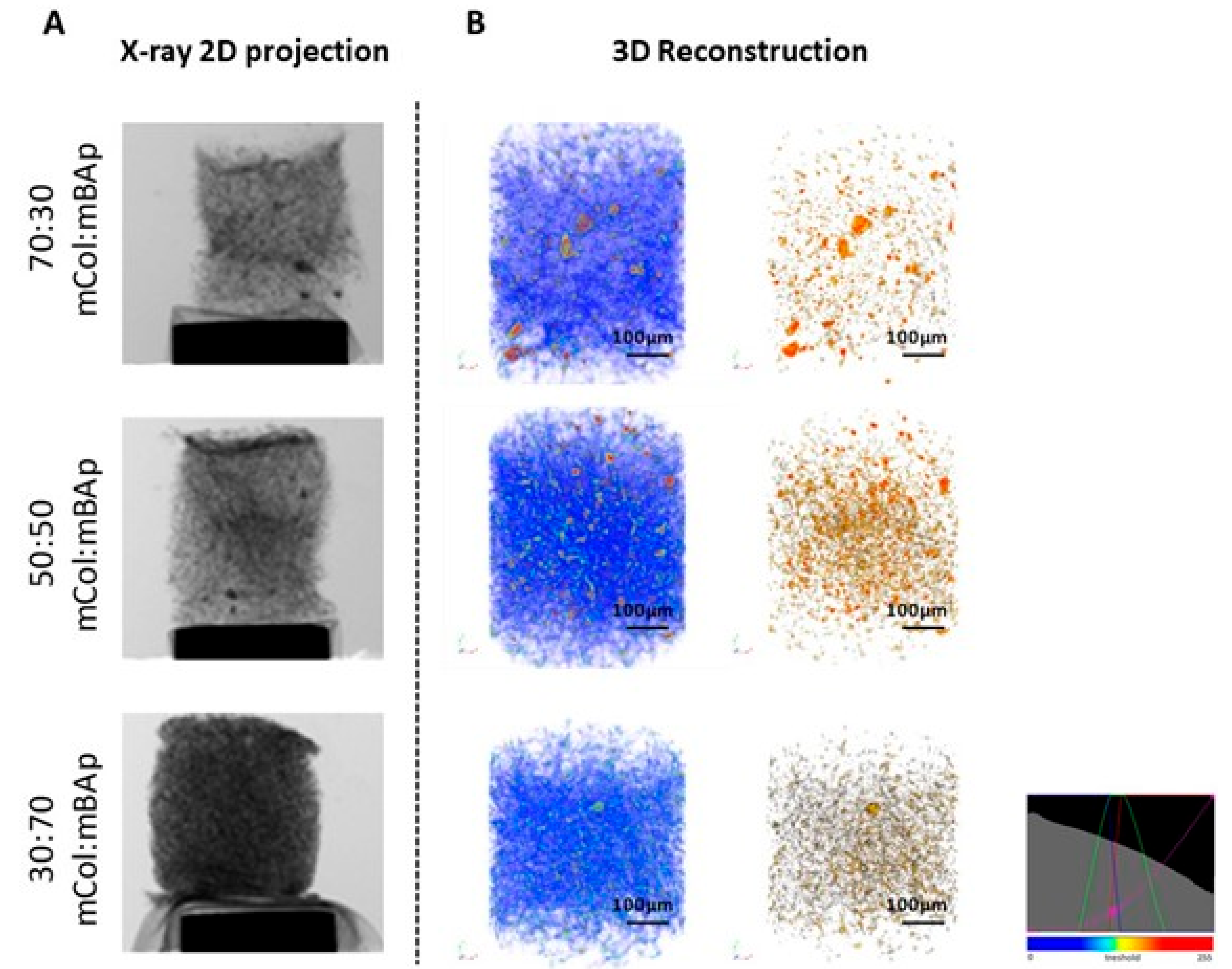


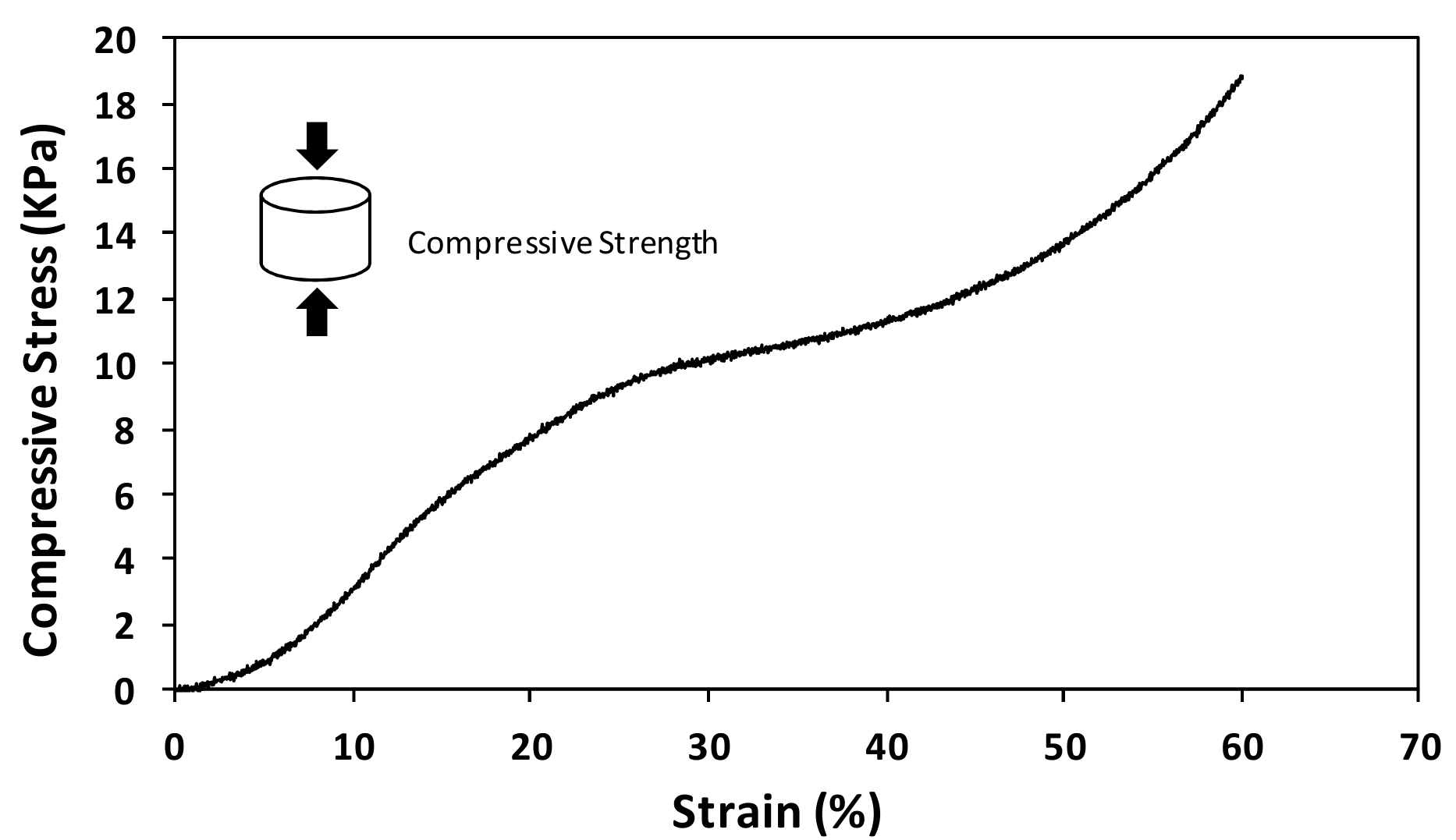
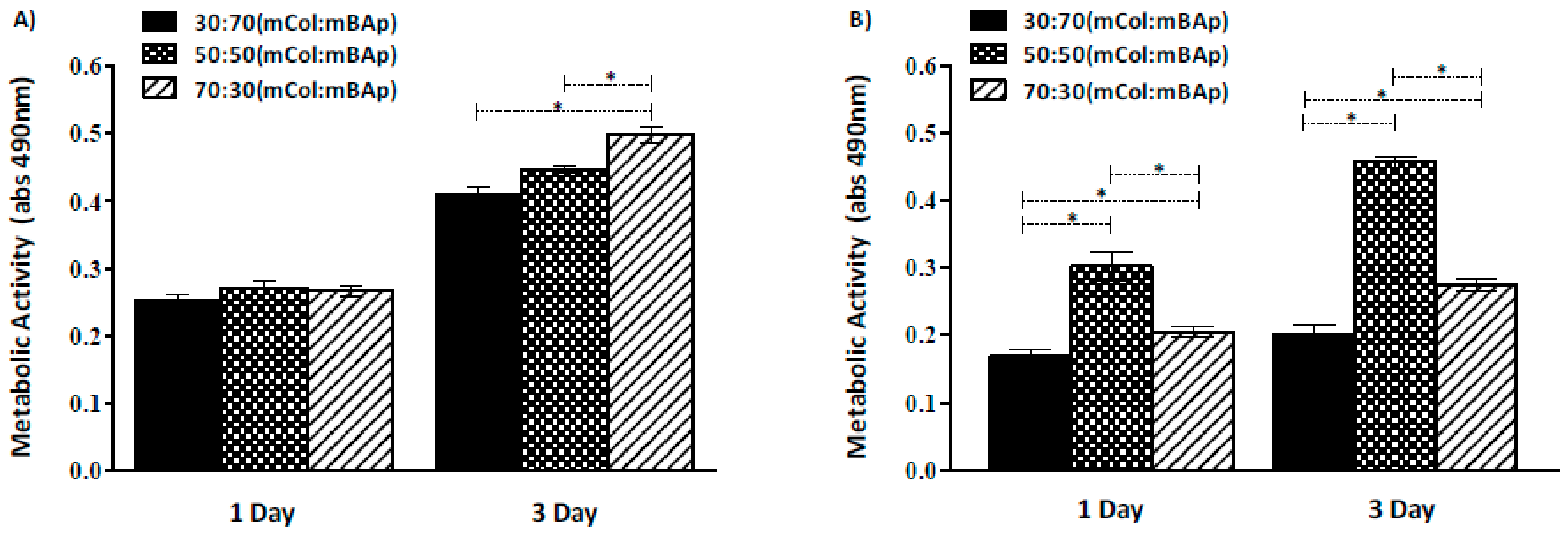
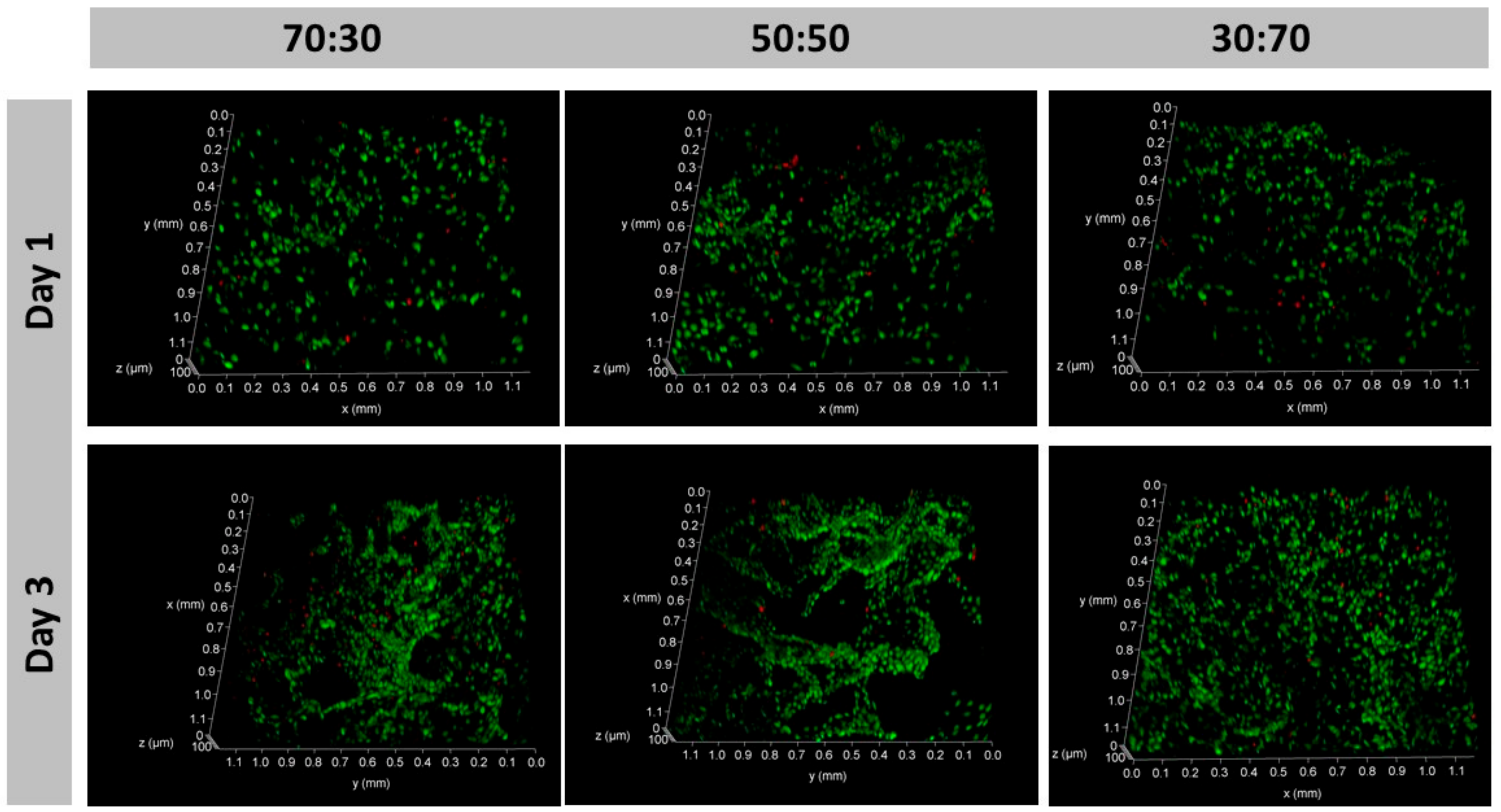
| Element | Weight (%) |
|---|---|
| Ca | 44.364 ± 5 |
| P | 22.8 ± 2.3 |
| F | 1.0 ± 0.5 |
| Na | 0.9 ± 0.2 |
| Mg | 0.65 ± 0.04 |
| Sr | 0.25 ± 0.02 |
| K | 0.018 ± 0.002 |
| Al | 0.007 ± 0.005 |
| Fe | 0.006 ± 0.003 |
| mCol:mBAp | 25% EDC/NHS | 12.5% EDC/NHS | 1% HMDI | 5% HMDI |
|---|---|---|---|---|
| 100:0 | + | − | − | − |
| 70:30 | ++ | ++ | − | ++ |
| 50:50 | ++ | ++ | − | ++ |
| 30:70 | ++ | ++ | − | ++ |
| mCol:mBAp | Crosslinker | Mean Pore Size (µm) | Porosity (%) | Trabecular Thickness (µm) | Inter-Connectivity (%) |
|---|---|---|---|---|---|
| 100:0 | 25% EDC:NHS | 45.5 ± 11.7 | 48.8 ± 14.8 | 45.1 ± 8.7 | 46.4 ± 15.9 |
| 100:0 | 12.5% EDC:NHS | 64.1 ± 5.7 | 72.7 ± 1.8 | 35.4 ± 5.4 | 69.3 ± 7.7 |
| 100:0 | 5% HMDI | 52.7 ± 11.0 | 76.3 ± 4.2 | 27.9 ± 5.5 | 81.5 ± 8.5 |
| 100:0 | 1% HMDI | 115.1 ± 35.6 | 87.2 ± 1.3 | 33.2 ± 2.9 | 69.4 ± 15.1 |
| 70:30 | 25% EDC:NHS | 56.5 ± 10.7 | 48.9 ± 3.4 | 51.9 ± 4.6 | 54.3 ± 1.9 |
| 70:30 | 12.5% EDC:NHS | 83.4 ± 11.8 | 78.3 ± 5.7 | 39.4 ± 1.6 | 92.1 ± 3.0 |
| 70:30 | 5% HMDI | 147.0 ± 38.4 | 90.4 ± 3.2 | 41.6 ± 2.7 | 97.3 ± 1.8 |
| 70:30 | 1% HMDI | 161.4 ± 13.7 | 91.8 ± 2.0 | 44.4 ± 3.2 | 97.4 ± 2.1 |
| 50:50 | 25% EDC:NHS | 50.5 ± 1.6 | 49.0 ± 3.1 | 47.9 ± 2.3 | 49.8 ± 4.8 |
| 50:50 | 12.5% EDC:NHS | 126.3 ± 22.5 | 85.4 ± 3.2 | 43.3 ± 0.67 | 96.8 ± 1.8 |
| 50:50 | 5% HMDI | 142.6 + 24.1 | 89.4 ± 3.0 | 43.2 ± 2.2 | 97.4 ± 1.6 |
| 50:50 | 1% HMDI | 155.1 ± 31.3 | 87.8 ± 5.3 | 46.1 ± 4.6 | 87.0 ± 11.8 |
| 30:70 | 25% EDC:NHS | 113.8 ± 16.0 | 69.3 ± 1.3 | 52.8 ± 2.1 | 65.7 ± 7.9 |
| 30:70 | 12.5% EDC:NHS | 104.4 ± 15.7 | 73.9 ± 1.9 | 47.0 ± 1.2 | 85.4 ± 2.4 |
| 30:70 | 5% HMDI | 62.6 ± 6.8 | 67.5 ± 4.2 | 40.8 ± 1.7 | 68.8 ± 9.8 |
| 30:70 | 1% HMDI | 172.0 ± 43.3 | 86.8 ± 8.2 | 46.8 ± 6.0 | 89.5 ± 9.5 |
© 2018 by the authors. Licensee MDPI, Basel, Switzerland. This article is an open access article distributed under the terms and conditions of the Creative Commons Attribution (CC BY) license (http://creativecommons.org/licenses/by/4.0/).
Share and Cite
Diogo, G.S.; López-Senra, E.L.; Pirraco, R.P.; Canadas, R.F.; Fernandes, E.M.; Serra, J.; Pérez-Martín, R.I.; Sotelo, C.G.; Marques, A.P.; González, P.; et al. Marine Collagen/Apatite Composite Scaffolds Envisaging Hard Tissue Applications. Mar. Drugs 2018, 16, 269. https://doi.org/10.3390/md16080269
Diogo GS, López-Senra EL, Pirraco RP, Canadas RF, Fernandes EM, Serra J, Pérez-Martín RI, Sotelo CG, Marques AP, González P, et al. Marine Collagen/Apatite Composite Scaffolds Envisaging Hard Tissue Applications. Marine Drugs. 2018; 16(8):269. https://doi.org/10.3390/md16080269
Chicago/Turabian StyleDiogo, Gabriela S., Estefania L. López-Senra, Rogério P. Pirraco, Raphael F. Canadas, Emanuel M. Fernandes, Julia Serra, Ricardo I. Pérez-Martín, Carmen G. Sotelo, Alexandra P. Marques, Pio González, and et al. 2018. "Marine Collagen/Apatite Composite Scaffolds Envisaging Hard Tissue Applications" Marine Drugs 16, no. 8: 269. https://doi.org/10.3390/md16080269











